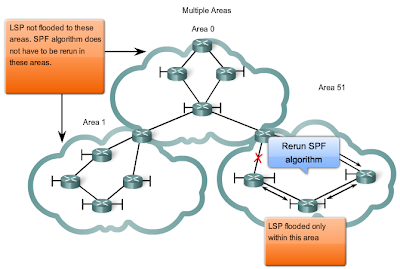CCNA Exploration 2.
Routing protocols and Consepts.
RESUME. Chapter 10. Link-state routing protocols
Link-state routing protocols are also known as shortest path first protocols and built around Edsger Dijkstra's shortest path first (SPF) algorithm.
1. Each router learns about its own links, its own directly connected networks. This is done by detecting that an interface is in the up state.
2. Each router is responsible for meeting its neighbors on directly connected networks. Similar to EIGRP, link state routers do this by exchanging Hello packets with other link-state routers on directly connected networks.
3. Each router builds a Link-State Packet (LSP) containing the state of each directly connected link. This is done by recording all the pertinent information about each neighbor, including neighbor ID, link type, and bandwidth.
4. Each router floods the LSP to all neighbors, who then store all LSPs received in a database. Neighbors then flood the LSPs to their neighbors until all routers in the area have received the LSPs. Each router stores a copy of each LSP received from its neighbors in a local database.
5. Each router uses the database to construct a complete map of the topology and computes the best path to each destination network. Like having a road map, the router now has a complete map of all destinations in the topology and the routes to reach them. The SPF algorithm is used to construct the map of the topology and to determine the best path to each network.
Each router learns about its own links, its own directly connected networks
With link-state routing protocols, a link is an interface on a router. As with distance vector protocols and static routes, the interface must be properly configured with an IP address and subnet mask and the link must be in the up state before the link-state routing protocol can learn about a link. Also like distance vector protocols, the interface must be included in one of the network statements before it can participate in the link-state routing process.
Each router is responsible for meeting its neighbors on directly connected networks.
Similar to EIGRP's Hello packets, when two link-state routers learn that they are neighbors, they form an adjacency. These small Hello packets continue to be exchanged between two adjacent neighbors which serve as a "keepalive" function to monitor the state of the neighbor. If a router stops receiving Hello packets from a neighbor, that neighbor is considered unreachable and the adjacency is broken.
Each router builds a Link-State Packet (LSP) containing the state of each directly connected link.
Once a router has established its adjacencies, it can build its link-state packets (LSPs) that contain the link-state information about its links.
Each router floods the LSP to all neighbors, who then store all LSPs received in a database.
Each router uses the database to construct a complete map of the topology and computes the best path to each destination network.
There are several advantages of link-state routing protocols compared to distance vector routing protocols:
~ Builds a Topological Map
~Fast Convergence~Event-driven Updates. OSPF routers do flood their own link-states every 30 minutes.
~Hierarchical Design
Modern link-state routing protocols are designed to minimize the effects on memory, CPU, and bandwidth. The use and configuration of multiple areas can reduce the size of the link-state databases. Multiple areas can also limit the amount of link-state information flooding in a routing domain and send LSPs only to those routers that need them.



Уряяя!))Давно искал exploration в текстовом виде, чтоб можно было распечатать и читать на парах и в транспорте!
ОтветитьУдалитьОгромное вам спасибо!
Я рада, что кому-то кроме меня это нужно.
УдалитьПостараюсь в скором времени отработать 3-й эксплорейшн)))